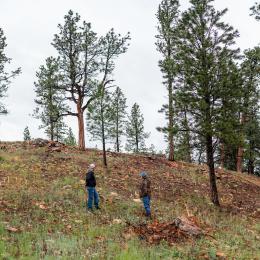After the Fire - Hazard Tree Removal
Hazard tree removal consists of removing dead and/or damaged trees that pose a hazard to people, animals, personal property, utilities, and other structures.
When should trees be removed?
Dead trees that pose a threat to life or property may be located adjacent to homes, outbuildings, access roads and other structures. Assessing tree mortality is an important step in determining the risk to life and property. Refer to University of Idaho Extension’s “After the Burn: Assessing and Managing Your Forestland after a Wildfire,” Washington Department of Natural Resources “Fire Injured Trees: Making an Initial Assessment of Whether a Tree is Likely to Die, “or Montana State University Extension Forestry’s “Wildfire Severity Photo-guide for Assessing Damage and Aiding Recovery of Trees and Forests across the Northern Rockies” for guidelines in assessing tree mortality.
How should trees be removed?
Work should be completed by qualified sawyers and/or equipment operators. Inspect the tree prior to felling to identify any hazards such as cracks, mistletoe brooms or deformities in the bole or canopy that could increase the complexity of felling the tree. When cutting hazard trees, you should try to limit soil disturbance and the number of vehicular trips across your land. This will help to minimize erosion and noxious weed introduction. All branches should be cut from the tree and the trunk of tree should lay flat on the soil surface. Cut-tree material is often more valuable left on-site. Broadcasting chips from dead trees back onto the burned land can help reduce erosion. Log erosion barriers may help stabilize soils on slopes in some areas (see specification on Log Erosion Barriers). In addition, lopping and scattering limbs and finer material can help reduce surface water flow, erosion and improve soil condition by replacing organic matter and nutrients.
Safety precautions
Removing hazardous trees in burned areas is dangerous due to a significant risk that burned trees may fall unexpectedly or drop branches on workers with little or no warning- especially during times of high winds, heavy precipitation, and/or saturated soils. Always use the appropriate personal protection gear when operating a chainsaw, such as: hard hat, gloves, eye protection, hearing protection, chaps, and steel toed boots. Use chainsaws with spark arresters and review their safety instructions. Review safety instructions when using ATVs or other machinery
In the years following the fire, many of the trees will begin to fall on their own as roots, trunks, and limbs decay. Landowners should continue to be aware of these hazards.

"CAUTION: After a fire, many trees are weakened from burning around the base of the trunk. These trees can fall over or blow down without warning. Shallow-rooted trees can also fall. Therefore, be extremely alert around burned trees.
Additional Information
Montana Forestry Resources
NRCS Montana guides for forest management and wildfire recovery.
NRCS Forestry Web Page
Forestry and agroforestry information and technical resources that apply to all States.

